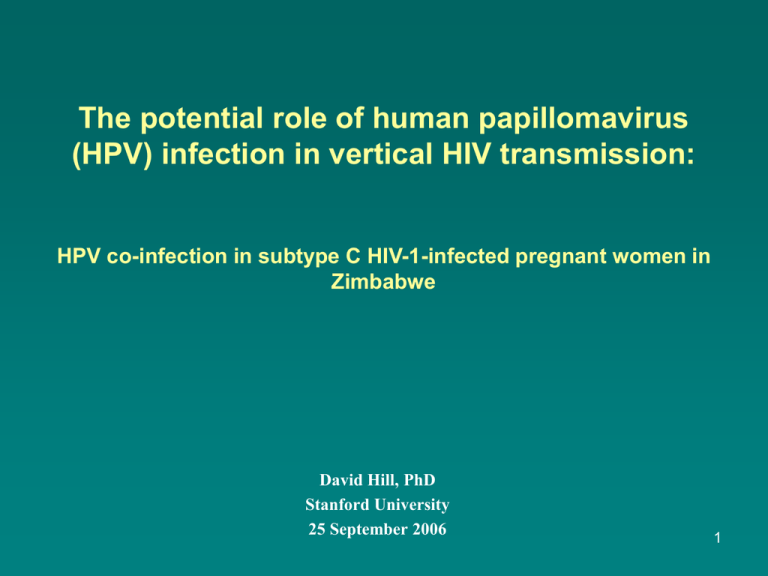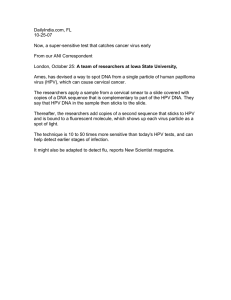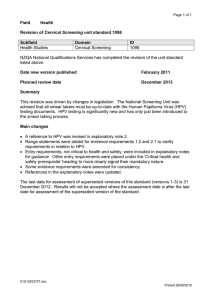The Potential Role of Human Papillomavirus (HPV)
advertisement

The potential role of human papillomavirus (HPV) infection in vertical HIV transmission: HPV co-infection in subtype C HIV-1-infected pregnant women in Zimbabwe David Hill, PhD Stanford University 25 September 2006 1 2 HPV: what is it? • a DNA virus that causes epithelial proliferations at cutaneous and mucosal surfaces • 106 genotypes have been identified (likely ~100 more); >30 infect anogenital epithelium • HPV is transmitted by skin-to-skin contact • Biggest single risk factor: high # of sexual partners 3 HPV: what is it? • Genital infection with HPV is the world’s most common STI; ~80% of sexually active people are infected at some point in life • Most HPV infection is transient, asymptomatic, resolves w/o treatment – 70% clear within 1 year; >90% clear within 2 years – Median duration of new infection: ~8 months • Persistent infection with high-risk types causes almost all (99%+) cervical cancer 4 HPV: what’s ‘high-risk’? • High-risk types – Associated with invasive cancers (esp. cervical) – common types: 16, 18, 31, 33, 35, 39, 45, 51, 52, 56, 58, 59, 68, 82 • Low-risk types – Cause low-grade cell changes and genital warts – common types: 6, 11, 40, 42, 43 44, 54, 61, 72, 73, 81 5 HPV and cervical cancer • HPV infection peaks in young women (early sexual activity) • Cervical cancer typically follows 20-30 years later • Cervical cancer affects 0.5 – 1.5 million women per year – Kills nearly 0.25 million per year • 80% of cervical cancer cases are in the developing world – Major health inequity • Highest incidence: sub-Saharan Africa & Latin America • Prevention: regular gyn screening (pap) & treatment of precancerous lesions 6 HPV vaccines • June 2006: the US FDA licensed Merck’s Gardasil – quadrivalent, protects against 6, 11, 16, 18 • Trials showed: safe, good immune response, efficacious • Guards against 70% of cervical cancers and 90% of genital warts • Later in June ’06: the Advisory Committee on Immunization Practices (ACIP) recommended routine vaccination for girls 11-12 years; also made vaccine available to 9-26 year olds. 7 HPV vaccines • GSK vaccine (still in phase III) – bivalent, protects against types 16 & 18 • Why not develop a vaccine with 7 types? Technical hurdles are many • Mathematical models indicate that these vaccines (vs. 16 & 18) will reduce an individual’s lifetime risk of developing cervical cancer by ~50% (no ref) 8 HPV: purpose of our study 1. To define prevalence and types of HPV in HIV-1-infected pregnant women in urban Zimbabwe – HPV prevalence reported elsewhere: • ~30% in (sexually active) general population – Estimated worldwide prevalence of 400-500 million – Little geographic variation • ~60% among HIV-infected women 2. To pilot an investigation of the association of HPV infection with MTCT – Based on our knowledge of other sexually transmitted infections (STIs), and their role in facilitating HIV transmission 9 Rationale for our study • Much evidence of STIs amplifying HIV transmission – Non-ulceratives: inflammation, increase local presence of targeted cells – Ulcerative STIs: provide portals of entry – Presence may increase amount of virus shed in genital tract • STIs in the context of HIV has generally not included HPV – HPV *should* be considered b/c of this potential influence on immune response & physical lesions • Our hypothesis is that HPV in genital tract will increase HIV shedding & may facilitate HIV transmission to infants • Understanding this relationship may help us develop more comprehensive treatment & prevention strategies 10 This,…in the context of HIV 11 Global HIV and AIDS statistics by region, end of 2005 N (%) People living with HIV People newly infected with HIV Deaths due to AIDS Sub-Saharan Africa 25.8 million (64%) 3.2 million (65%) 2.4 million (77%) North America 1.2 million (3%) 43,000 (0.9%) 18,000 (0.6%) World total 40.3 million (100%) 4.9 million (100%) 3.1 million (100%) UNAIDS, World Health Organization 12 13 Children (<15 years) estimated to be living with HIV end 2005 N [%] North America 9 000 [0.4%] Sub-Saharan Africa 2.1 mill. [91%] Total: 2.3 (2.1 – 2.8) million Total children living with HIV: 2.3 million UNAIDS, World Health Organization 14 Children (<15 years) estimated to be living with HIV, and dying of AIDS end 2005 N [%] North America 9 000 [0.4%] 100 [0.02%] Sub-Saharan Africa 2.1 mill. [91%] 520,000 [91%] Total: 2.3 (2.1 – 2.8) million Total children living with HIV: 2.3 million Total children dying of AIDS: 570,000 UNAIDS, World Health Organization 15 Features of perinatal HIV/AIDS: a “tale of two epidemics” Industrialized, RICH countries Developing, POOR countries Perinatal HIV burden ~1% 99% AIDS mortality by 2 years < 0.10 ~ 0.50 Chronic Fatal Condition 16 LM Newell et al, Lancet 2004; 364 and L Mofenson Research in PMTCT of HIV 1994 Name of protocol Sites Therapy MTCT rate(%) v. placebo PACTG 076 USA, France ZDV v. placebo 8 v. 25 EM Connor et al, NEJM 1994;331 17 Number of Cases Incident pediatric AIDS Cases in the U.S. acquired via perinatal HIV, 1985-1999 Quarter-Year CDC 18 Five antiretroviral therapy (ART) trials for PMTCT 1999-2003 Name of protocol Sites Therapy Low MTCT rates (%) v. placebo / other ANRS049a/ DITRAME Ivory Coast, Burkina Faso Short ZDV v. placebo 15 v. 22 CDC-Retro-CI Ivory Coast Shorter ZDV v. placebo 12 v. 22 PETRA South Africa, Tanzania, Uganda ZDV+3TC Three arms plus placebo 6 v. 9, 14, 15 HIVNET 012 Uganda Single dose NVP v. super short ZDV 12 v. 20 SAINT South Africa ZDV+3TC short v. Single dose NVP 9 v. 12 Dabis 1999; Wiktor 1999; Saba 2002; Jackson 2003; Moodley 2003; pooled analysis in Leroy AIDS 2005 19 So, what did we find? 20 Prevalence of HPV and types of HPV HPV status HPV Positive HPV Negative Total N=57 44 (77%) 13 (23%) HPV type n HPV type n 6 2 56 3 11 1 58 9 16 3 59 9 18 4 61 8 26 1 66 8 31 1 68 2 33 1 69 7 40 1 70 5 45 1 73 3 52 4 AE2 4 53 6 Pap155 3 54 1 Pap291 1 55 4 Generic only 10 21 Maternal characteristics, by HPV status (N=57) No statistically significant differences were identified across groups in any category Maternal HPV status Characteristic Positive Negative n=44 n=13 Age Mean (SD) Range 24.7 (5.0) 17-37 25.5 (6.1) 16-36 Years education Mean (SD) Range 9.2 (2.2) 2-13 9.7 (1.6) 7-11 Age at first intercourse Mean (SD) Range 18.9 (2.5) 12-26 18.0 (4.5) 6-24 No. sex partners, lifetime Mean (SD) Range 2.0 (1.2) 1-6 1.4 (0.7) 1-3 CD4+ cell count, cells/mm3 Mean (SD) Range 344 (233) 11-1055 328 (143) 50-542 22 Prevalence of maternal HPV, by infant HIV status Infant HIV infection status HPV status Total N=57 Positive n=6 Negative n=37 Unknown n=14 HPV Positive 44 (77%) 5 (83%) 27 (73%) 12 (86%) HPV Negative 13 (23%) 1 (17%) 10 (27%) 2 (14%) 23 Prevalence of HPV by high and low risk groups in all mothers and in groups of infant HIV status Total HPV type* N=57 Any high-risk type 33 (58%) High-risk, 56-likea 15 (26%) High-risk, 18-likeb 23 (40%) High-risk, 16-likec 15 (26%) Low riskd 8 (14%) Other/unk typese 22 (39%) No HPV 13 (23%) *Subgroups of subjects (by phylogenetic category) were not mutually exclusive. a 53, 56, 66 b 18, 26, 45, 59, 68, 69, 70 c 16, 31, 33, 52, 58 d 6, 11, 40, 54, 55 e 61, 73, AE2, Pap 155, Pap 291, generic probe positive only 24 Prevalence of HPV by high and low risk groups in all mothers and in groups of infant HIV status Total HPV type* Positive Infant HIV infection status Negative Unknown N=57 n=6 n=37 n=14 33 (58%) 5 (83%) 18 (49%) 10 (71%) High-risk, 56-likea 15 (26%) 3 (50%) 5 (14%) 7 (50%) High-risk, 18-likeb 23 (40%) 4 (67%) 11 (30%) 8 (57%) High-risk, 16-likec 15 (26%) 1 (17%) 9 (24%) 5 (36%) Low riskd 8 (14%) 1 (17%) 3 (8%) 4 (29%) Other/unk typese 22 (39%) 2 (33%) 13 (35%) 7 (50%) No HPV 13 (23%) 1 (17%) 10 (27%) 2 (14%) Any high-risk type *Subgroups of subjects (by phylogenetic category) were not mutually exclusive. a 53, 56, 66 b 18, 26, 45, 59, 68, 69, 70 c 16, 31, 33, 52, 58 d 6, 11, 40, 54, 55 e 61, 73, AE2, Pap 155, Pap 291, generic probe positive only 25 Logistic regression models: Risk of vertical HIV transmission in HPV-positive and HPV-negative mothers (adjusted for baseline maternal CD4+ cell count) Total number of HIV+ mothers HIV-infected infants OR (95% CI)a Pb Any HPV None 32 11 5 1 1.90 (0.20 – 18.42) 1.0 0.58 High riskc Low riskd/Othere None 23 18 11 5 3 1 6.05 (0.61 – 59.78) 1.50 (0.24 – 9.38) 1.0 0.12 0.67 Maternal HPV type a OR, odds ratio; CI, confidence interval 2-tailed P value c High-risk HPV: any 16-like, 18-like, or 56-like HPV d Low-risk HPV types: 2, 6, 11, 13 , 32, 40, 42, 44, 54, 55, 57, 62, 72 e Other HPV types: 61, AE2, Pap155, Pap291, 73, mixture, or consensus probe positive only b 26 Conclusions • A high proportion of HIV-infected pregnant women in this population have cervical HPV infection • A broad diversity of HPV types is present • There is a high prevalence of HPV types associated with increased risk of cervical cancer • This preliminary assessment of HPV carriage warrants further study of – HPV types – HIV cervical shedding – the association between HPV and MTCT of subtype C HIV-1 27 Acknowledgments • • • • • • • • • • David Katzenstein Bonnie Maldonado Julie Parsonnet Richard Roberts Kristin Cobb Avinash Shetty Catherine Ley Joel Palefsky Patrick Mateta Lynn Zijenah 28 Factors affecting perinatal HIV: worlds apart Industrialized, resource-rich Developing, resource-poor – Funding available • Stable infrastructures • Someone pays • Robust health system – Economic barriers • Lack of infrastructure • Lack of money • Lack of people – Fewer social barriers • Advocacy – Social, cultural barriers • Stigma – Governments act • Advocacy – Government barriers • Lack of political will 29



